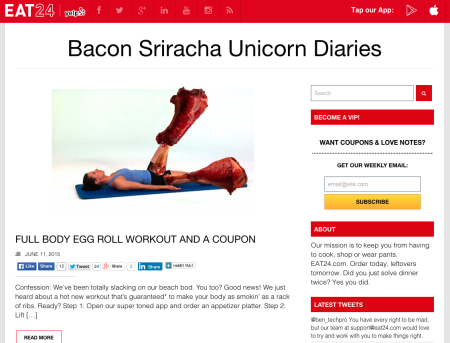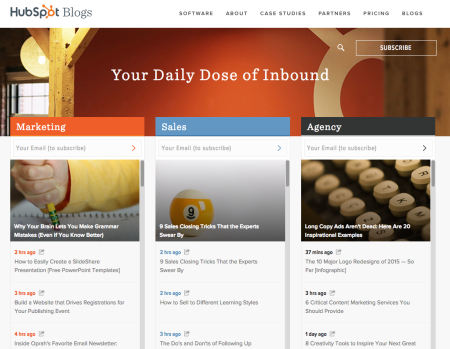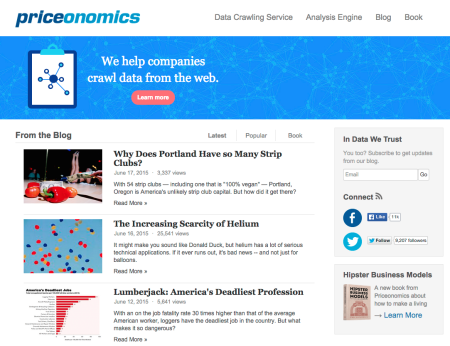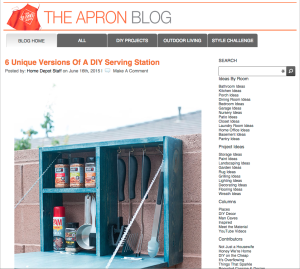Have you ever seen a blog that’s so useful, looks so good, and gets so much user engagement that you look back at your own blog and ask, “Why do I even bother?”
Similarly, if you don’t blog, it might be because you see amazing (and not-so amazing) content all over the web and think “it’s all been done.” 
It hasn’t all been done, though, because you haven’t done it.
You’re the expert in your field, and that’s what makes marketing for contractors so valuable. Chances are that other blogs have expressed your ideas, but they haven’t expressed those ideas like only you can.
You have the ability to share your unique experiences and wisdom with a huge audience, and blogging is a great way to do that.
If you’re ever feeling frustrated and don’t know how to start or continue, take a look at these five blogs we’ve compiled. They serve their audiences perfectly with useful, interesting content that keeps people coming back.
Remember, great artists steal bits and pieces from everything around them; you can “steal” some great ideas from these blogs (for the record, we don’t endorse outright plagiarism). Once you employ some of these ideas and tailor them to your own blog, you’ll agree that there’s a reason to Bother With Blogging.
We know you’re busy, so we’ve compiled three example posts and three great takeaways from each blog you can use today.
Eat24

Everyone eats and, once in a while, everyone feels lazy. It’s for that reason that Eat24 was in a good spot even before their blog took off. Eat24 is an app that aggregates food delivery options in your area and allows you to order from your mobile device.
Eat24’s app has broad appeal, but their blog targets a certain audience. They use irreverent and often absurd humor in every blog and social media post they make. Check out this post explaining their app’s integration with Yelp’s data. That’s big news, right? They could have been straightforward about it, but they still employed their trademark sense of humor.
Example posts:
- A business proposal to Domino’s – This post uses hard data to show Domino’s why they should team up with Eat24. It’s still full of Eat24’s carefree, slacker-style humor, but it also goes fairly deep into data and the reasons behind it. The user engagement is definitely worth checking out, too. Eat24’s audience loves them, and they respond in kind.
- Customer Shoutouts – Eat24 loves its customers right back. In this post, they hand-crafted shoutouts for their customers. All a customer needed to do for a shoutout was ask. Eat24 went above and beyond by creating images and writing poems. Each shoutout was a delight to Eat24’s target blog audience.
- A Today Show Fiasco – Eat24’s new app was featured on the Today Show, but when the hosts demonstrated the app live on the air, anchor Tamron Hall’s phone number was displayed to the entire country. Eat24, of course, used the incident to make some jokes and plug their new HANGRY app some more. It never feels forced or pushy, it just feels like Eat24 is being Eat24.
Eat24’s blog is successful and engrossing because they harness their unique personality. It just oozes out of every pore of their online presence. Their irreverent tone is consistent in everything they do, from big merger announcements to hard data to posts about coupons.
Eat24 has a unique voice their audience loves, and they maintain that voice across every platform. Anyone can write about corporate partnerships and analyze data, but Eat24’s voice is what makes their online presence popular.
It’s important to find your own voice, though: don’t copy someone else’s. We reached out to Eat24 about marketing for contractors, manufacturers and other “less glamorous” industries.
Right from Eat24’s mouth:
Honestly, humor isn’t the best for every product or service. It works great for us because food and funny seems to go together like burgers and fries. If we were working for a dentist or a construction company, we’d want to be mindful of our audience. Would they appreciate humor? Would it even work for them? That being said, we’re pretty sure we could make some great teeth puns.
Eat24 is also great at engaging their customers and making them feel special. When a brand continuously and publicly converses with its customers, new customers feel good about signing on.
Takeaways:
- Find your natural voice and use it consistently across your marketing platforms.
- Your voice and personality separate your blog from thousands of other contractors.
- Delight your users by being responsive, engaging and appreciative.
Construction Informer
 Construction Informer isn’t as big or as popular as Eat24, but it exists in a more specific niche. As a contractor, Construction Informer is probably relevant to what you do. It’s also proof that marketing for contractors can include a great blog.
Construction Informer isn’t as big or as popular as Eat24, but it exists in a more specific niche. As a contractor, Construction Informer is probably relevant to what you do. It’s also proof that marketing for contractors can include a great blog.
Construction Informer publishes writing from various, different contractors and people in the AEC industry. The blog includes how-tos, gear reviews, news, management tips, and more. It’s an efficient, utilitarian blog that gets the job done. You can probably relate.
Contractors don’t always have time to sit at a desk in between jobs, so Construction Informer’s content is mostly short-form and gets straight to the point. It also showcases many varied viewpoints and stories to better connect with different AEC professionals.
Example Posts:
- A book review – In this post, the author delivers a quick review of a book that’s targeted at new contractors. He walks you through the book and tells you exactly why it’s worth your time. He doesn’t write a novel just to review a book. It’s a useful, quick review.
- Management tips – This post gets at the human reason behind failing projects. The author analyzes poor management and the motivation for not properly training workers or allocating enough labor to a project. There’s plenty of real research cited in this post, and the important quotes are presented in bold, green letters for skimmers. This is also a shorter post, but it’s a well researched piece of content that’s perfect for Construction Informer’s audience.
- Labor Law News – This piece lays out a change in labor laws, and it lays the news out plainly and quickly. It cites its sources and explains why this news is important to you, the AEC professional.
Construction Informer is more low key than Eat24, but it fits its target audience perfectly. It’s useful, it cites its sources and it never wastes time.
Takeaways
- Know your audience and understand how they spend their time online
- Offer something useful, such as news and how-tos. This should come naturally for contractors
- Do your research. Citing relevant research improves your credibility and shows your audience that you’re an expert
HubSpot
HubSpot is a successful internet marketing company, formed in 2006. They are the thought leaders in the world of inbound marketing, and their software empowers companies all over the world to provide great marketing services. 
Their blog is a premiere educational destination for marketers. Every single post is educational and well-written. HubSpot’s blog is successful because they give away great, educational content for free and let their audience know there’s even more content available when they sign up. Their content is valuable and their blog converts readers into customers.
HubSpot’s blog offers content in five distinct areas– marketing, sales, agency, academy (inbound marketing training) and web design. It’s easy to find what you’re looking for and start learning.
Example Posts:
- Email newsletter examples – This lengthy posts explores 15 email newsletters and why they’re successful. The author goes in depth with each piece of email marketing and breaks it down so you’ll learn the anatomy of a great newsletter.
- 18 Sales Quotes – This post aggregates 18 quotes from successful salespeople who lay down some truth on the reader. Sales is different today than it was 15 years ago, and this post lets real people explain and educate with brief, snappy quotes.
- Why Workshops Work – This post is both educational and convincing. It explains how workshops can influence a real culture shift toward inbound marketing for prospective clients. It also features a great interview with an industry expert, giving it an extra value push. This is unique, useful content.
HubSpot’s blog is also well-designed and easy to use. It’s welcoming, but it also conveys an air of intellectualism, not unlike an educational institution. They’ve provided value and established themselves as thought leaders.
You might not have HubSpot’s staff and resources, but you can take something away from their approach.
Takeaways:
- Provide educational content for free. It will show your audience that you’re an expert, and they’ll come to you when there’s a job they can’t accomplish themselves.
- Thought leaders establish themselves with industry-defining content.
- Usability is important. If your audience can’t find your content, they’re going to head elsewhere.
Priceonomics
 Priceonomics offers data crawling and analysis services for businesses. They also happen to run a great blog with a crazy amount of variety.
Priceonomics offers data crawling and analysis services for businesses. They also happen to run a great blog with a crazy amount of variety.
Priceonomics is successful because they harness the power of data (as their service would entail) and use it to craft engaging stories. Every word of every blog post demands to be read because they let data and real people work together to compel their audience.
They’re also masters of selling their product, both their services and their book, Hipster Business Models. They tell fascinating stories and leave a polite (but noticeable) attention-getter at the bottom of each post, advertising their book. After reading some of their work, you’d be hard pressed to completely ignore the existence of that book.
Example Posts:
- One-Hit Wonders – This post uses data from the Billboard Hot 100 charts to tell the story of one-hit wonders. More specifically, it gives insight into why one-hit wonders might be a thing of the past. It’s compelling for both the music lover and the data geek.
- The Texas Deep Frying Champion – This one is just a great slice of-life-story. By the end of it, you feel like you understand Abel Gonzales Jr., his world and his craft. There are, of course, some interesting economic stats included, too.
- Why Comic Shops Won’t Die – This is another slice-of-life story, but it explores both the economics and the psychology of comic shops. When most other periodicals and their retailers are dying a slow death, comic shops still eke out an existence. It’s a fascinating story based on both humanity and business.
The people at Priceonomics are expert storytellers. Consumers love stories, so they naturally connect with businesses and blogs who tell great stories. They also show the power collecting and analyzing data, which reflects well on their service.
They’re great at using their blog to sell products and services without seeming pushy. These are longer, in-depth reads– but that’s what Priceonomics’ audience wants.
Takeaways:
- People love a good story. You’re a contractor, so you and the people around you have lived great stories. Use them to your blogging advantage.
- Your blog should convince potential customers of your expertise. Priceonomics uses data and analysis; you can use your industry knowhow, too.
- A good call-to-action is important. Priceonomics is great at selling their book (and their services) through their blog without being loud or pushy
The Home Depot
 Much like HubSpot, The Home Depot has the resources to publish and maintain a robust blog. Much of The Home Depot’s blog content comes from outside contributors, but they’re not just people looking for a quick way to promote their personal websites; almost every post on The Home Depot’s blog is an in-depth tutorial with stunning photos.
Much like HubSpot, The Home Depot has the resources to publish and maintain a robust blog. Much of The Home Depot’s blog content comes from outside contributors, but they’re not just people looking for a quick way to promote their personal websites; almost every post on The Home Depot’s blog is an in-depth tutorial with stunning photos.
There’s a real sense of community at the Home Depot blog because of its many contributors. User engagement is high, both on social media and on the website itself. These are useful how-tos written by real people, and the photos showcase each project perfectly.
THD’s blog is also well-organized: by project type, room of the house, author, and various columns. This level of organization makes it easy for users to find a project and get to work. The blog also links to The Home Depot’s product pages in each post’s ‘materials needed’ section, which is another win for The Home Depot.
Example Posts:
- Dresser Makeover – Just look at those photos. This is a cool project with clear, step-by-step instructions and a great finished product, but the photos make it something special. It also features some clever Home Depot product placement.
- Man Cave Infographic – This tongue-in-cheek post targets Father’s Day Gift ideas. It’s funny and it plays to stereotypes without being offensive. The infographic itself is great, too.
- Patio Creation – This post tells a great story in the vein of Priceonomics. Through showing the process of her patio makeover, the author tells the story of living in her home and gives the reader a glimpse of her every day life. The little details and photos are incredible, too. It’s both useful and engaging.
Home Depot’s blog also creates great social engagement, mostly through Pinterest. Pinterest is a surprisingly huge social network for The Home Depot’s audience, and home DIY projects are a great fit with that particular social network.
We spoke with The Home Depot’s blog manager, Laura Fries:
One of the best things about working for The Home Depot is that we have the opportunity to share real DIY stories on our blog. As the largest home improvement retailer in the world, our customers are DIYing great projects every day. We’ve been lucky enough to find very talented contributors who can share their ideas with clear writing and inspiring photography.
The community has also turned out for a recent contest: that’s a lot of comments for a corporate blog.
The Home Depot’s blog is active, useful and community oriented. It serves both its core audience and casual users well with large, attractive images, which are essential for blogs.
Laura, again:
It’s easy to build a great blogging community when you love your work – we have a great time collaborating with our contributors on creative and inspiring projects. The Home Depot is the platinum sponsor of the Haven Conference for DIY bloggers, which is our annual meetup with many of our contributors. We stay connected through Instagram, Pinterest and of course checking out everyone’s projects on their blogs.
Though you don’t sell housewares and you probably don’t have Home Depot’s resources, their blog is a perfect example of what a handy contractor can put into a simple blog post. You know remodeling and construction, so show the world your knowledge. Audiences, especially homeowners, love a good before-and-after.
Home Depot’s succeeds on its visual appeal, its usefulness, and the strength of its community.
Takeaways:
- A strong blog community helps build engagement. People are excited to read, share and comment. This keeps them coming back.
- Great images are important. People love visual representations of projects and before-and-after photos.
- A variety of post-types will keep your blog from becoming stale. Variety is good, but relevance is still a must
These five blogs exemplify the power of blogging. A good blog shows your expertise and engages readers. Potential customers are looking for experts, and since the contracting world is so competitive, your voice needs to rise above the rest. A blog with clear goals and great content turns readers into customers.
To your inbound marketing success!

